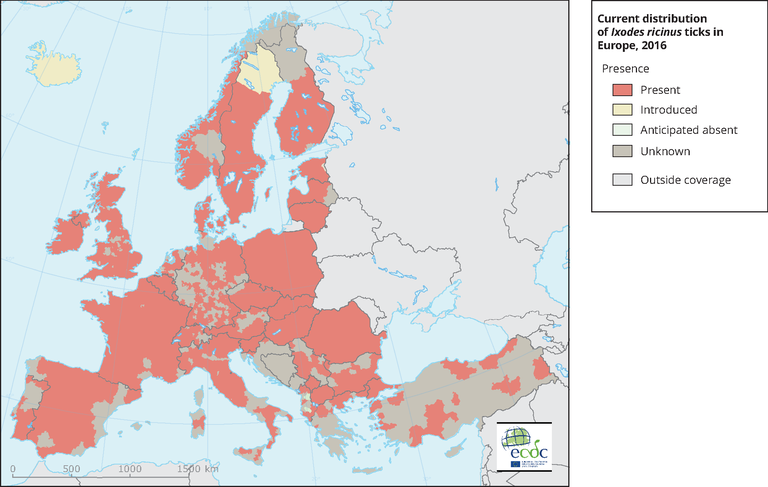
European Ticks and the Diseases They May Carry
- Ixodes ricinus (Castor Bean Tick): Anaplasma phagocytophylum, Babesia spp, Borrelia burgdorferi, Borrelia afzelii, Borrelia garinii, Borrelia bavariensis, Borrelia spielmanii, Borrelia miyamotoi, Rickettsia spp, and Tick-Borne Encephalitis (TBE) virus.
- Ixodes persulcatus (Taiga Tick): Borrelia afzelii, B. garinii, B. valaisiana, Borrelia miyamtoi, Rickettsia spp, Tick-Borne Encephalitis (TBE) Virus.
- Hyalomma marginatum (Mediterranean Hyalomma): Crimean-Congo hemorrhagic fever virus.
- Dermacentor reticulatus (Ornate Cattle Tick): Rickettsia slovaca, R. raoultii (tick-borne lymphadenopathy (TIBOLA)), Tick-Borne Encephalitis virus.
- Dermacentor marginatus (Ornate Sheep Tick): Rickettsia slovaca, R. raoultii (tick-borne lymphadenopathy (TIBOLA)), Coxiella burnetii (Q Fever), Crimean-Congo hemorrhagic fever virus.
Since ticks in North America do not carry Tick-Borne Encephalitis virus or Crimean-Congo Hemorrhagic Fever virus, it’s essential to be aware of the symptom profiles for these diseases, which can be acquired overseas.
Tick-Borne Encephalitis (TBE) Symptoms:
1. Early Symptoms (first 5 days):
- Fever
- Fatigue
- Headache
- Muscle pain
- Nausea
2. Asymptomatic Phase (7 days):
3. Symptomatic Phase Phase:
- Meningitis
- Meningoencephalitis
- Myelitis
- Paralysis
- Radiculitis
Crimean-Congo Hemorrhagic Fever Symptoms:
- Fever
- Headache
- Muscle pain
- Malaise
- Light sensitivity
- Abdominal pain
- Diarrhea, vomiting
- Hemorrhagic symptoms (may include petechiae, nosebleeds, bruising, severe hemorrhages)
Prevention Tips
- Use tick repellents: DEET or TickShield by Cedarcide, a natural cedarwood oil spray safe for humans and dogs over 20 pounds, applied every 1-2 hours.
- Permethrin Treatment: Treating socks and sneakers with permethrin decreases the chance of getting a tick bite by 73 times! Before you pack, treat shoes, socks, clothing and gear with permethrin. Wear gloves (permethrin is toxic to our skin when wet) when you spray down materials outdoors. Safe to touch when dry. Treatment lasts 6 weeks with do-it-yourself treatment.
- Perform nightly body checks for ticks after a day of potential exposure. Ticks love warm, moist areas, so be thorough.
- Put your clothes in the dryer (skip the washer) on high for 6 minutes after coming indoors. This kills ticks effectively.
If you get bitten by a tick, save the tick for testing. Place it in a ziplock bag and send it to a trusted facility such as TickReport once you return home. This is crucial, especially if you develop symptoms after a tick bite. Watch for symptoms especially over the next 30 days from a tick bite: “bull’s eye” or other rash around tick bite, fever, flu-like symptoms, joint pain or swelling, muscle pain, headaches, neck pain, facial palsy, lymph node swelling, palpitations, night sweats, air hunger or non-exertional shortness of breath, chest pain, nausea, vomiting, abdominal pain, loss of appetite, cough, sore throat, confusion, disorientation, difficulty breathing or speaking, loss of coordination, seizures, lethargy, paralysis, body rash. Report symptoms to a health care provider. You can find doctors on Project Lyme’s provider search.
Bringing awareness and taking preventive measures can significantly reduce the risk of tick-borne diseases. For more detailed information and resources, consider reviewing the new online course “Preventing Lyme and Tick-Borne Diseases: Ticks from Around the World, Diseases They Carry, Prevention, and Acute Treatments” by Alexis Chesney available here: https://health-transformations.teachable.com/p/preventing-lyme-and-other-tick-borne-diseases.
By staying informed and taking these preventive steps, you can enjoy a safer travel experience this summer.
About the Author
Alexis Chesney ND, LAc is a naturopathic physician and acupuncturist specializing in the treatment of Lyme and other tick-borne diseases. For more information about her book and her protocols, see her website https://www.dralexischesney.com/.



